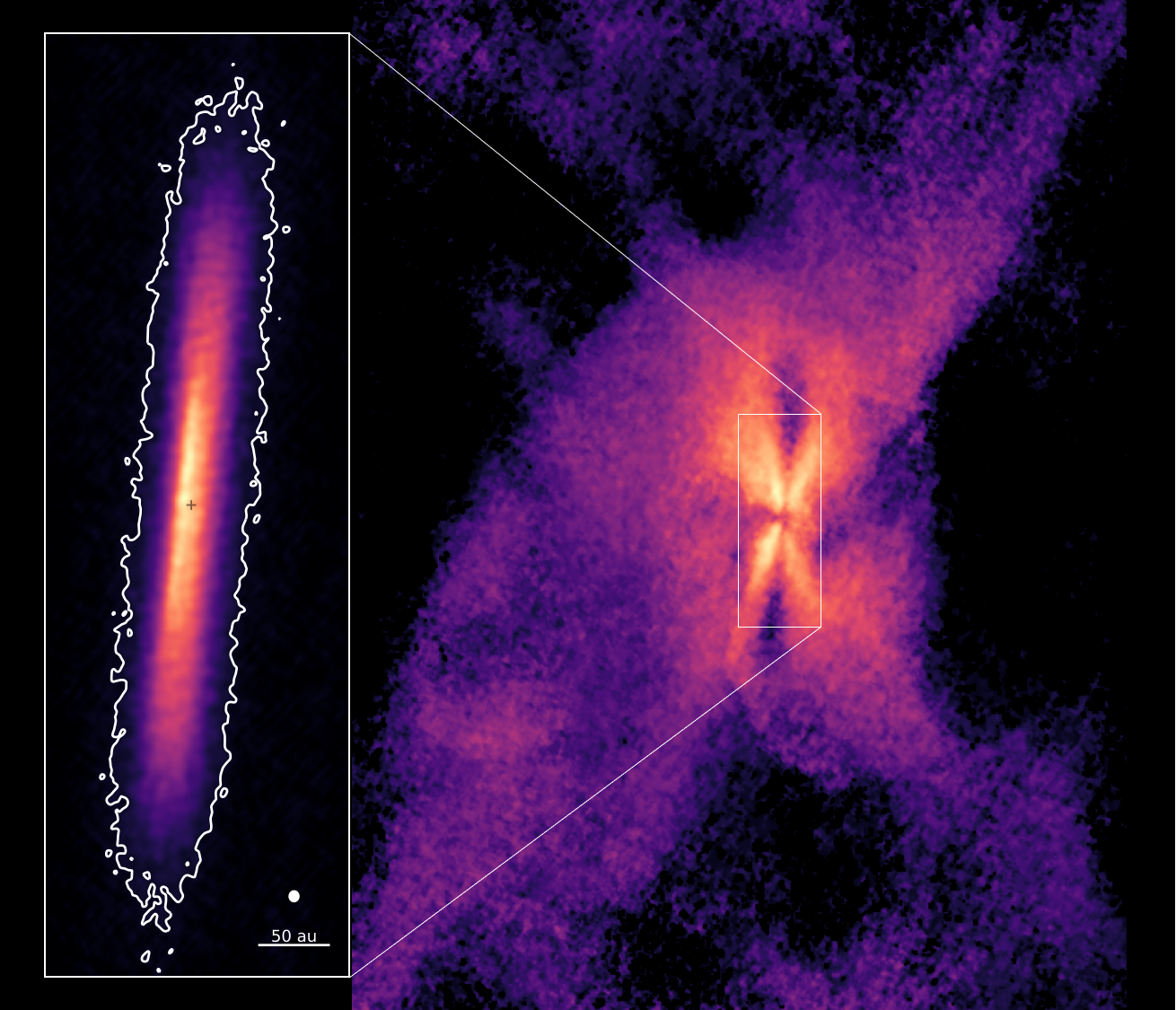Dust Settling 塵埃沉降
Protoplanetary disks are the birthplaces of planets where dust plays a crucial role in planet formation. Part of my research focuses on understanding dust settling, a key process that should increase the midplane dust-to-gas ratio to enable the growth of planetesimals. Using high-resolution observations from the Atacama Large Millimeter/submillimeter Array (ALMA), I have studied disks at different evolutionary stages to trace the progression of dust settling. 原行星盤是行星的誕生之處,其中塵埃在行星形成過程中扮演著重要的角色。我研究之一著重於理解塵埃沉降。這過程很關鍵,能增加中平面的塵埃與氣體密度比率,從而促進微行星的增長。利用阿塔卡馬大型毫米波/次毫米波陣列(ALMA)的高解析度觀測,我研究了不同演化階段的原行星盤,以追蹤塵埃沉降的進程。
In the earliest stages of disk evolution, represented by the Class 0 source HH212mms, we observe a remarkable structure: a clear dark lane sandwiched between two bright lanes in the dust continuum at ~1 mm. This configuration provides evidence that the dust is significantly elevated, tracing the warm surface layers of the disk. Our analysis shows that the dust is coupled to the gas in hydrostatic equilibrium. This suggests that dust has not yet settled towards the midplane in this very young system. 第零類幼星體HH212mms處於盤演化中最早的階段。我們觀察到一個顯著的結構:在波長約1毫米的塵埃連續體中,出現一條明顯的暗帶,夾在兩條亮帶之間。這種結構提供了證據表明塵埃分佈達到中平面之上,沿著盤面的暖層。我們的分析顯示,塵埃與氣體耦合,均處於靜水平衡狀態。這表明在這個非常年輕的系統中,塵埃尚未向沉降至中平面。

As part of the Early Planet Formation in Embedded Disks (eDisks), our observations of the Class I protostar IRAS 04302+2247, nicknamed the "Butterfly Star," reveal an optically thick and geometrically thick disk when viewed edge-on. At this stage, we find that the dust scale height is comparable to the gas pressure scale height. This suggests that even in the Class I phase, significant vertical dust settling has not yet occurred. These findings challenge our understanding of dust evolution timescales and have important implications for planet formation theories, indicating that the process of dust settling may be slower or more complex than previously thought. 我作為「隱盤中的早期行星形成」團隊(eDisks)的一員,對第一類幼星體IRAS 04302+2247(綽號「蝴蝶星」)的觀測顯示,當從盤側角觀看時,它是一個光學厚且幾何厚的盤。在這個演化階段,我們發現塵埃的標高與氣體標高相當,表明即使在第一類階段,顯著的塵埃沉降尚未發生。這些發現挑戰了我們對塵埃演化時間尺度的理解,揭示塵埃沉降的過程可能比先前認為的更慢或更複雜,並足以對行星形成理論產生影響。
Future Directions 未來展望
The insights gained from this series of research open up exciting avenues for future investigation and have far-reaching implications for our understanding of planet formation. Moving forward, I aim to expand our sample size, studying more edge-on disks across various evolutionary stages to build a comprehensive picture of dust settling progression. High-resolution multi-wavelength observations may allow us to probe different grain sizes and their settling behaviors. 這系列的研究所獲得的見解為未來的調查開闢了令人興奮的途徑,並對我們理解行星形成有深遠的影響。在未來,我的目標是擴大我們的樣本量,研究跨越各種演化階段的更多側向盤,以建立塵埃沉降進程的全面圖景。高解析度的多波長觀測可能允許我們探測不同粒徑的塵埃及其沉降行為。